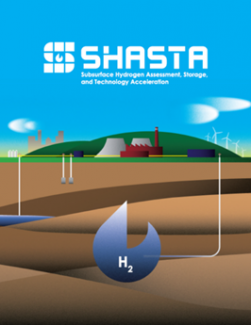Safe large-scale geological hydrogen storage is important in the national drive to use hydrogen to attain net-zero carbon emission goals by 2050. Conclusive research to determine the effect of gas injections on the naturally occurring underground microbial community and geochemical reactions between hydrogen and rock mineralogy are critical research subjects in that effort.
Microorganisms, or microbes, are organisms that consist of a single cell or a cluster of similar cells that cannot be seen with the naked eye. Both in mass and number, microbes are the most prevalent organisms on earth. Bacteria, microscopic algae, yeast cells and protozoa are diverse examples of microbes.
Microbial communities are naturally present in underground reservoirs at a broad range of environmental conditions. These naturally present microbial communities are known to consume hydrogen under certain environmental conditions.
In addition, geochemistry issues are under study in relation to underground storage of hydrogen. Geochemistry is concerned with the application of chemistry to aspects of geology. Hydrogen stored underground could interact with fluids in storage formations and rock mineralogy, potentially causing migration pathways through rocks, a loss of hydrogen from underground storage, and production of other gases.
NETL is working on microbial and geochemical reaction issues with national laboratory colleagues in a research partnership called SHASTA, the Subsurface Hydrogen Assessment, Storage and Technology Acceleration partnership that includes NETL, the Pacific Northwest National Laboratory and Lawrence Livermore National Laboratory. One of SHASTA’s key goals is to determine the technical feasibility of hydrogen storage in subsurface systems and quantify the operational risks associated with storage in those systems.
SHASTA will develop technologies and tools that will reduce those risks. At the same time, the research effort will establish the technical basis for reusing existing natural gas storage infrastructure for the hydrogen economy.
NETL researcher Djuna Gulliver said it is important to be aware of microbial communities because they drive a range of potential reactions involved with underground hydrogen storage including:
- Methanogenesis, when microorganisms called methanogens oxidize hydrogen and reduce carbon dioxide to produce methane.
- Hydrogen sulfide production, when hydrogen consumption occurs through sulfate reducers producing hydrogen sulfide gas. Several models demonstrate that some reservoirs targeted for hydrogen storage have a high risk of sulfide gas production from interactions with sulfate reducers.
- Microbiological corrosion, when microbially induced corrosion of steel and other materials has been documented to occur after introduction of hydrogen to the subsurface. Hydrogen-consuming microorganisms have caused corrosion.
- Secondary effects, like when shifting microbial communities lead to unexpected byproducts, such as organic acids or even calcium carbonate scaling, that could contribute to corrosive mineral reactions and production of various acids.
According to SHASTA, some private companies have documented microbial impacts on energy storage systems. French company Gaz de France found methanogens consumed 50% of stored hydrogen gas. Czech Republic gas storage fields reported consumption of stored hydrogen coupled with hydrogen sulfide.
“Knowledge gaps require research and laboratory tests to investigate the effect of hydrogen on the subsurface microbial community before initiating large-scale injections,” Gulliver said.
Meanwhile, NETL’s Barbara Kutchko said geochemical reactions between hydrogen, formation fluids and rock mineralogy are important to understand and predict so that cementing of storage facilities remains uncompromised. Some geologic components like clay minerals, oxides, sulfates, and carbonates that serve as pore-filling minerals cementing storage reservoirs may be susceptible to reactions with dissolved hydrogen.
“Before we can store hydrogen safely and securely in underground reservoirs, the effects of gas injection resulting from geochemical reactions must be assessed,” Kutchko said. “That’s why NETL’s work with SHASTA will help develop technologies and tools to make underground storage of hydrogen effective and safe.”




